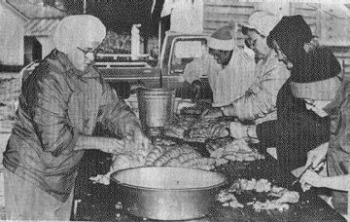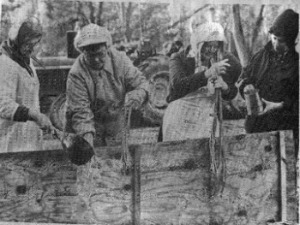Let us consider what chitlins are – they are hog intestines or guts
Some people turn up their noses at the mention of chitlins; other leave the house while they are cooking, driven away by their odor. They are a food that you either love or hate!
However, the volume sold for New Year’s dinners, with Christmas and Thanksgiving not far behind, attests to chitlins popularity in the United States. Chitterlings is the more formal name, but most people call them chitlins. They are usually part of a larger meal that includes collard greens, fried chicken, and other traditional Southern foods. Chitlins are not for the faint of palate or smell, which is why traditionally they were cooked outdoors at backyard hog killings in winter.
Chitlins take a lot of time and effort to clean. They are partially cleaned when they are sold, but require additional hand cleaning before they are ready to eat. The secret to good and safe chitlins is in the cleaning, not in the cooking. They are available in supermarkets in African-American neighborhoods, especially during the holiday season. They can also be ordered from a butcher, but be prepared to buy 10 pounds of chitlins to get 5 pounds to cook.
Photos courtesy of J. B. Coltrain, County Extension Director, North Carolina State University, Raleigh, NC
History of Chitterlings/Chitlins:
Animal innards have long been treasured foods around the world. Scotland’s national dish is haggis (sheep’s stomach stuffed with the animal’s minced heart, liver, and lungs). Throughout Europe, tripe (cow or ox stomach) is popular, and French chefs in upscale restaurants serve dishes based on cow’s brains and kidneys.
In 1966, the town of Salley, South Carolina, inaugurated the annual Chitlin’ Strut. The first festival attracted about a hundred people. Today the festival draws about 70,000 people. It is estimated that more than 128,000 pounds of chitlins have been eaten during the festival’s history.
Eating chitlins in the rural South is not as common as it once was. In colonial times, hogs were slaughtered in December, and how maws or ears, pigs feet, and neck bones were given to the enslaved. Until emancipation, African-American food choices were restricted by the dictates of their owners, and often fed the enslaved little more than the scraps of animal meat that the owners deemed unacceptable for themselves. Because of the West African tradition of cooking all edible parts of plants and animals, these foods helped the enslaved survive in the United States.
The informal circuit of juke joints and clubs patronized by African Americans has long been called the “Chitlin Circuit.” The Chitlin’ Circuit was a string of music venues in the South that sold chitlins’ and other soul food dishes. In the late 50’s and early 60’s these tours were crucial to Black artists. Because there was no media coverage for these artists, the Chitlin’ Circuit was the only way to perform for their fans.
By mid-century there were several active chitterling eating clubs – Royal Order of Chitlin Eaters of Nashville, Tennessee and the Happy Chitlin Eaters of Raleigh, North Carolina.
There is even a song on chitlins called Chitlin Cookin’ Time in Cheatham County:
There’s a quiet and peaceful county in the state of Tennessee
You will find it in the book they call geography
Not famous for its farming, its mines, or its stills
But they know there’s chitlin cookin’ in them Cheatham County hills
When it’s chitlin cookin’ time in Cheatham County I’ll be courtin’ in them Cheatham County hills
And I’ll pick a Cheatham County chitlin cooker
I’ve a longin’ that the chitlins will fill
Most families who love to cook chitlins have their own recipe passed down from generation to generation. My friend, Andra Cook of Raleigh, North Carolina, says her mother, Martha McCollum, always fried the chitlins after they were simmered.
Andra says, “If you can get past the smell, they have an interesting flavor. When my mother prepared them, the whole neighborhood smelled!”
- 10 -pound bucket chitterlings, fresh or frozen
- Cold water to cover
- 1 cup cider vinegar
- 5 bay leaves
- 2 large onions, coarsely chopped
- 2 large potatoes, peeled and coarsely chopped
- 1 green or red bell pepper, cored, seeded, and coarsely chopped
- 3 cloves garlic, minced
- Salt and freshly-ground black pepper to taste
- Hot pepper sauce
-
Cleaning Chitterlings: Soak the chitterlings in cold water throughout the cleaning stage. Each chitterling should be examined and run under cold water and all foreign materials should be removed and discarded.
-
Chitterlings should retain some fat, so be careful to leave some on.
-
Using a small soft brush, clean chitterlings thoroughly; rinse in several changes of cold water. Cut into 1 1/2 to 2-inch pieces.
-
Place the cleaned chitterlings into a large pot; cover with water and vinegar. Add bay leaves, onions, potatoes, green or red pepper, garlic, salt, and pepper. Bring to a boil; turn heat to low and simmer approximately 2 1/2 to 3 hours or until chitterlings are tender. Remove from heat and drain well.
-
Serve with your favorite hot pepper sauce.
-
Makes 6 servings.
Health Officials Issue Precautions for Preparing Chitterlings
by Virginia Health Department
Families across Virginia will soon be cooking holiday meals. If your meal includes chitterlings (pig intestines), the Virginia Department of Health has recommendations for preparation that will keep your family from getting sick.
"When preparing chitterlings the best way to avoid bacterial contamination and illness is to buy pre-cooked chitterlings," recommends State Health Commissioner Robert Stroube, M.D., M.P.H. "If raw chitterlings are used, they should be preboiled for five minutes before preparing as usual. Pre-boiling makes cleaning chitterlings easier and faster and does not change the taste."
Dr. Stroube warns that bacteria in raw chitterlings or pig intestines can cause severe diarrhea, especially in infants. Chitterlings, commonly called chitlins, may contain the Yersinia bacteria. The bacteria are spread from raw chitterlings by hands or by eating or drinking contaminated food or liquids.
"Preparing chitlins is a lengthy process. Contamination within the home is hard to avoid. Baby food or formula should not be prepared or handled while preparing chitterlings due the potential for contamination. Infant formula or food should not be placed anywhere near raw chitterlings in the refrigerator. The Yersinia bacteria are different than many bacteria, because they multiply and spread even in the cold," Dr. Stroube said.
Yersinia can cause severe diarrhea, bloody diarrhea, abdominal pain and fever. The symptoms usually begin within three to seven days after contact with the bacteria. Infants and small children who contract yersiniosis may require hospitalization, although the illness rarely causes death. Older children and adults may experience appendicitis-like stomach pain.
The Virginia Department of Health recommends the following tips when cooking chitlins:
Wrap the container containing the raw chitlins in plastic wrap when thawing in the refrigerator.
Keep children out of the kitchen until the chitlins are pre-boiled and the kitchen is thoroughly cleaned.
Handle raw chitlins as little as possible until after they have been pre-boiled.
Keep raw chitlins away from all baby food and formula.
After touching the chitlins, wash your hands with warm water and soap, and clean under your nails.
Clean sinks and all places touched by raw chitlins or their juice with hot soapy water or a chlorine bleach solution.
Wrap all waste promptly and throw into an outside garbage can.
Clean all pots, pans, buckets and utensils in the dishwasher or in hot soapy water.
Wash dishcloths, towels or sponges used in cleanup in hot water.



9 Responses to “Chitterlings (Chitlins) History and Recipe”
Beverly Tillman
This artical is so totally wrong. The history of chattering began with slavery.
Slaves were given hoofs( pigs feet), ears, tongues, neck bones,and guts of the pig. This is the true history.
Anonomous
That’s what this article is implying.
Joe
So true and they learned how to cook it just fine and delicious. I am a true white southerner and I love to eat it all!
A chitlins fan
I’ve been eating chitlins since I was a small child. My mom is from NOLA and I’ve never seen her boil them before cooking them; no one got sick. I cook them the same way and no one ever got sick and I’m 58. All I use is vinegar, cuts down on the fat, and salt and pepper. Everybody wants a bowl when they find out they are being cooked by my friend or myself. When you’re ready to eat them don’t forget to have that hot sauce on the table.
Tracie Ann Carmell Jones
Thanks
Lynette
Was wondering why pre boil never heard of it my people are from Cheraw SC. I been eating them all my life. Thats just a waste of time. If you boil for 21/2 to 3 hours the aint nothing left to kill… What do yo think?
Gwen Lawrence
65 year old African American female never boiled before cooking,my chitterlings are de👍😍😋😋
Ruby Clark
I was born in the deep South Mississippi. I learned from my Mother and Grandmother on how to clean chitlins. I wash my chitlins, and boil them for four hours, place my seasoning on them,…salt, Red and yellow sweet peppers a little taste of vinegar and they are delicious along with homemade Coleslaw and side of corn bread, hot sauce and for sure Collar greens on the side.
Linda McCarter
I’m 58 and I love chittlings. My sons do too. I was born and raised in California but my parents and family is born and raised in Louisiana. No one boils them before cleaning. We were taught how cook VERY WELL. We soak them in cold water and vinegar. Go through them and pick the particles and excess off. Put them on the other side of the sink in more water. When first cleanse is done…go through them again on the other side of the sink but not without washing and rinsing the 1st side of the sink. Rinse them through 4 or 5 waters. When done with ALL of them…place them in a pot with water and some vinegar. Boil them for 2 hrs. Drain off the water…rise them and place them back in the pot with onions, green, red, yellow Bellpepper, 2 stalks or celery cut into half, garlic cloves or minced or chopped, bay leaves, black pepper, garlic powder, onion powder, seasoning salt, creole seasoning and 2Tb. spoon of vinegar. Let cook until it comes to a boil and then simmer until tender. It wouldn’t hurt to mix them with some hog maws. When done…have your favorite hot sauce ready. They are great with greens, cornbread, yams, macaroni and cheese, blackeye peas, fried chicken, fried turkey, potato salad or coleslaw. Dessert: Peach Cobbler, Carmel Cake or Red Velvet Cake, Homemade Ice Cream. Beverage: Arnold Palmer, Berry Lemonade, Fruit type Punch.
There it is…New Years Hurry Up!!!!